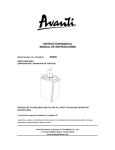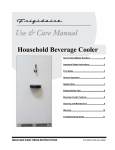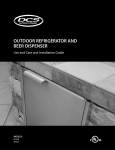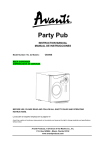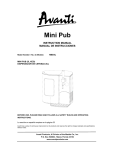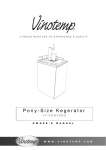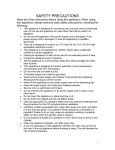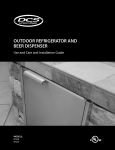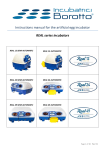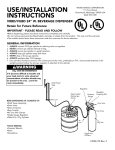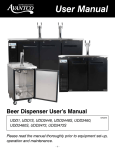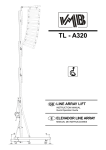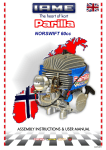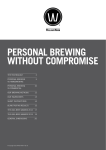Download Avanti BD7000 User's Manual
Transcript
INSTRUCTION MANUAL MANUAL DE INSTRUCCIONES Model Number/ No. De Modelo: BD7000 Beer Dispenser Dispensador / Enfriador de Cerveza BEFORE USE, PLEASE READ AND FOLLOW ALL SAFETY RULES AND OPERATING INSTRUCTIONS. La sección en español empieza en la página 23. Avanti has a policy of continuous improvement on its products and reserves the right to change materials and specifications without notice. Avanti Products, A Division of The Mackle Co., Inc. P.O. Box 520604 - Miami, Florida 33152 www.avantiproducts.com Table of Contents Appliance Safety 3 Important Safeguides 4 Help Us Help You 5 Parts and Features 6–7 Important Safety Instructions 8 Installation Instructions 8 Before Using Your Appliance 8 Installation of Your Appliance 8 Electrical Connection 9 Reversing the Door Swing of Your Appliance 10 Installing and Assembling Your Appliance 10 – 14 Converting Your Beer Dispenser to an ALL-Refrigerator Unit 14 Operating Your Appliance 15 Temperature Control 15 Defrosting Your Appliance 15 Care and Maintenance 15 Cleaning Your Appliance 15 Vacation Time 15 Moving Your Appliance 15 Draught Beer Trouble Guide 16 – 20 Troubleshooting Guide 21 Service for Your Appliance 21 Your Avanti Products Warranty 22 Instrucciones en Español 23 – 33 Registration Information and Registration Card 35 2 BEER DISPENSER SAFETY Your safety and the safety of others are very important. We have provided many important safety messages in this manual for your appliance. Always read and obey all safety messages. This is the Safety Alert Symbol. This symbol alerts you to potential hazards that can kill or injure you and others. All safety messages will follow the Safety Alert Symbol and either the words” DANGER”, “WARNING” or “CAUTION”. Danger means that failure to heed this safety statement may result in severe personal injury or death. Warning means that failure to heed this safety statement may result in extensive product damage, serious personal injury, or death. Caution means that failure to heed this safety statement may result in minor or moderate personal injury, property or equipment damage. All safety messages will alert to know what potential hazard is, tell you how to reduce the chance of injury, and let you know what can happen if the instructions are not followed. 3 IMPORTANT SAFEGUIDES Before the appliance is used, it must be properly positioned and installed as described in this manual,so read the manual carefully. To reduce the risk of fire, electrical shock or injury when using the appliance, follow basic precaution, including the following: Plug into a grounded 3-prong outlet, do not remove grounding prong, do not use an adapter, and do not use an extension cord. Replace all panels before operating. It is recommended that a separate circuit, serving only your appliance be provided. Use receptacles that cannot be turned off by a switch or pull chain. Never clean appliance parts with flammable fluids. These fumes can create a fire hazard or explosion. And do not store or use gasoline or other flammable vapors and liquids in the vicinity of this or any other appliance. The fumes can create a fire hazard or explosion. Before proceeding with cleaning and maintenance operations, make sure the power line of the unit is disconnected. Do not connect or disconnect the electric plug when your hands are wet. Unplug the appliance or disconnect power before cleaning or servicing. Failure to do so can result in electrical shock or death. Do not attempt to repair or replace any part of your appliance unless it is specifically recommended in this manual. All other servicing should be referred to a qualified technician. FOLLOW WARNING CALL OUTS BELOW ONLY WHEN APPLICABLE TO YOUR MODEL Use two or more people to move and install appliance. Failure to do so can result in back or other injury. To ensure proper ventilation for your appliance, the front of the unit must be completely unobstructed. Choose a well-ventilated area with temperatures above 60°F (16°C) and below 90°F (32°C). This unit must be installed in an area protected from the element, such as wind, rain, water spray or drips. The appliance should not be located next to ovens, grills or other sources of high heat. The appliance must be installed with all electrical, water and drain connections in accordance with state and local codes. A standard electrical supply (115 V AC only, 60 Hz), properly grounded in accordance with the National Electrical Code and local codes and ordinances is required. Do not kink or pinch the power supply cord of appliance. The fuse (or circuit breaker) size should be 15 amperes. It is important for the appliance to be leveled in order to work properly. You may need to make several adjustments to level it. All installation must be in accordance with local plumbing code requirements. Make certain that the pipes are not pinched or kinked or damaged during installations. Check for leaks after connection. Never allow children to operate, play with or crawl inside the appliance. If you use the drainage container, you must set the drain select switch to OFF or the water can overflow from the drainage container Although the unit has been tested at the factory, due to long-term transit and storage, the first batch of cubes must be discarded. Do not use solvent-based cleaning agents of abrasives on the interior. These cleaners may damage or discolor the interior. Do not use this apparatus for other than its intended purpose. 4 HELP US HELP YOU... Read this guide carefully. Write down the model and serial numbers. It is intended to help you operate and maintain your new Beer Dispenser properly. You'll find them on a plate located on the rear wall of the Beer Dispenser. Keep it handy to answer your questions. If you don't understand something or you need more assistance, please call: Please write these numbers here: ____________________________________ Date of Purchase Avanti Customer Service 800-220-5570 ____________________________________ Model Number Keep proof of original purchase date (such as your sales slip) with this guide to establish the warranty period. ____________________________________ Serial Number CAUTION: Use these numbers in any correspondence or service calls concerning your Beer Dispenser. THIS BEER DISPENSER IS NOT DESIGNED FOR THE STORAGE OF MEDICINE OR OTHER MEDICAL PRODUCTS. If you received a damaged Beer Dispenser, immediately contact the dealer (or builder) that sold you the Beer Dispenser. Save time and money. Before you call for service, check the Troubleshooting Guide. It lists causes of minor operating problems that you can correct yourself. IF YOU NEED SERVICE We're proud of our service and want you to be pleased. If for some reason you are not happy with the service you receive, here are some steps to follow for further assistance. FIRST, contact the people who serviced your Beer Dispenser. Explain why you are not pleased. In most cases, this will solve the problem. NEXT, if you are still not pleased, write all the details, including your telephone number, and send to: Customer Service Avanti Products 10880 NW 30 Street Miami, FL 33172 USA 5 PARTS AND FEATURES 1 2 3 4 5 6 Beer Tower Safety Guard Rail Drip Tray Adjustable Temperature Control Pressure Regulator Evaporator 7 8 9 10 11 12 6 Stainless Steel Door CO2 Tank Holder CO2 Tank Keg Support Plate Leveling Leg Standard Leg PARTS / ACCESSORIES - DETAILED Accessories 1. Keg Coupler 2. Back Flow Stopper 3. Rubber Washer 4. CO2 Rubber Directional Washer 5. Beer Tower Washer 6. Beer Tower Tap/Beer Hose Assembly 7. CO2 Regulator 8. High Pressure Washer 9. CO2 Tank Valve 10. Guard Rail 11. Drip Pan Top 12. Drip Pan 13. Rubber Foot 14. Keg Support Plate 15. Metal Washer 16. Caster with Brake (Optional – Sold Separately) 17. Casters (Optional – Sold Separately) 18. CO2 Tank Strap 19. Air hose Wing Nut Washer 20. Air Hose 21. Air Hose Connector Washer 22. Beer Tap Wrench 23. Regulator Wrench 24. Beer Tower Hole Cover 25. Extra Washers (3, 4, 8, 19, 21) 7 Qty 1 1 1 1 1 1 1 1 1 1 1 1 4 1 4 2 2 1 1 1 1 1 1 1 1 IMPORTANT SAFETY INSTRUCTIONS To reduce the risk of fire, electrical shock, or injury when using your Beer Dispenser, follow these basic precautions: Read all instructions before using the unit. DANGER or WARNING: Risk of child entrapment. Child entrapment and suffocation are not problems of the past. Junked or abandoned appliances are still dangerous . . . even if they will “just sit in the garage a few days”. Before you throw away your old unit: Take off the door. Leave the shelves in place so that children may not easily climb inside. Never allow children to operate, play with, or crawl inside the unit. Never clean unit parts with flammable fluids. The fumes can create a fire hazard or explosion. Do not store or use gasoline or any other flammable vapors and liquids in the vicinity of this or any other unit. The fumes can create a fire hazard or explosion. -Save these instructions- WARNING INSTALLATION INSTRUCTIONS Before Using Your Beer Dispenser Remove the exterior and interior packing. Check to be sure you have all of the following parts: 1 Instruction Manual 1 Beer Keg Coupler (Sankey Tap) 1 Safety Guard Rail 10 Keg Coupler Sealing Rings (Plastic Bag) 1 Drip Tray Assembly (Two pieces) 1 Metal Wrench for Faucet installation 1 Beer Keg Support Plate (Plastic) 1 Steel Clamp for Hose (RED) installation 2 Refrigerator Shelves (Wire) 1 Beer Hose (Clear) with Sankey connector 1 Beer Tower Assembly 1 CO2 Tank and Accessories 1 – Faucet 1 – CO2 Cylinder / Tank (Empty) 1 – Pull Handle (Black) 1 – CO2 Cylinder / Tank Cushion 1 – Tower Top Cover (Plastic) 1 – CO2 Regulator 1 – Mylar Washer 1 – CO2 Air Hose (Red) with connector 2 – Faucet Sealing Rings (Plastic Bag) 1 – CO2 Cylinder / Tank – Holder / Fastener Before connecting the Beer Dispenser to the power source, let it stand upright for approximately 2 hours. This will reduce the possibility of a malfunction in the cooling system from handling during transportation. Clean the interior surface with lukewarm water using a soft cloth. Installation of Your Beer Dispenser This appliance is designed to be free standing indoor use only, and should not be recessed or built-in. If used outdoors, the unit must be protected from exposure to all types of harsh weather conditions. High temperatures will affect the units cooling efficiency. Place your Beer Dispenser on a floor that is strong enough to support the Beer Dispenser when it is fully loaded. Allow 5 inches of space between the back and sides of the Beer Dispenser, which allows the proper air circulation to cool the compressor and condenser. Locate the Beer Dispenser away from direct sunlight and sources of heat (stove, heater, radiator, etc.). Direct sunlight may affect the acrylic coating and heat sources may increase electrical consumption. Extreme cold ambient temperatures may also cause the Beer Dispenser not to perform properly. Avoid locating the Beer Dispenser in moist areas. Plug the Beer Dispenser into an exclusive, properly installed-grounded wall outlet. Do not under any circumstances cut or remove the third (ground) prong from the power cord. Any 8 questions concerning power and or grounding should be directed toward a certified electrician or an authorized Avanti Products service center. After plugging the appliance into a wall outlet, allow the unit to cool down for 2-3 hours before placing any contents in the Beer Dispenser compartment. ELECTRICAL CONNECTION Warning Improper use of the grounded plug can result in the risk of electrical shock. If the power cord is damaged, have it replaced by an authorized Avanti Products service center. This appliance should be properly grounded for your safety. The power cord of this appliance is equipped with a three-prong plug which mates with standard three prong wall outlets to minimize the possibility of electrical shock. Do not under any circumstances cut or remove the third ground prong from the power cord supplied. For personal safety, this appliance must be properly grounded. This appliance requires a standard 115/120 Volt AC ~/60Hz electrical ground outlet with three-prong. Have the wall outlet and circuit checked by a qualified electrician to make sure the outlet is properly grounded. When a standard 2-prong wall outlet is encountered, it is your responsibility and obligation to have it replaced with a properly grounded 3-prong wall outlet. The cord should be secured behind the appliance and not left exposed or dangling to prevent accidental injury. The appliance should always be plugged into its own individual electrical outlet which has a voltage rating that matches the rating label on the appliance. This provides the best performance and also prevent overloading house wiring circuits that could cause a fire hazard from overheated. Never unplug the appliance by pulling the power cord. Always grip the plug firmly and pull straight out from the receptacle. Repair or replace immediately all power cords that have become frayed or otherwise damaged. Do not use a cord that shows cracks or abrasion damage along its length or at either end. When moving the appliance, be careful not to damage the power cord. EXTENSION CORD Because of potential safety hazards under certain conditions, it is strongly recommended that you do not use an extension cord with this appliance. However, if you must use an extension cord it is absolutely necessary that it be a UL/CUL-Listed, 3-wire grounding type appliance extension cord having a grounding type plug and outlet and that the electrical rating of the cord be 115 volts and at least 10 amperes. SURGE PROTECTOR Most electrical appliances use a series of electric control boards to operate. These boards are very susceptible to power surges and could be damaged or destroyed. If the appliance is going to be used in an area or if your city / country is prone to power surges / outages; it is suggested that you use a power surge protector for all electrical devices / appliances you use. The surge protector that you select must have a surge block high enough to protect the appliance it is connected to. If you have any questions regarding the type and size of surge protector needed contact a licensed electrician in your area. Damages due to power surges are not considered a manufacturer covered defect and will void your product warranty. 9 Reversing the Door Swing of Your Appliance This appliance has the capability of the door opening from either the left or right side. The unit is delivered to you with the door opening from the left side. Should you desire to reverse the opening direction, please call service for reversal instructions. INSTALLING AND ASSEMBLING YOUR APPLIANCE Casters with Brake (OPTIONAL ACCESSORIES) Installation THESE CASTERS ARE NOT INCLUDED WITH YOUR UNIT. Casters can be ordered from the Avanti Parts and Service Department at 1-800-220-5570 or by using the Accessory Order Form included with this manual. Install the four casters with lock provided into the unit’s bottom (four screw holes pre-supplied). Figure (I) before installation. Figure (II) is the final version. Figure (I): Before Installation Figure (II): After Installation WARNING CO2 GAS CAN BE DANGEROUS WARNING: CO2 cylinders contain high-pressure compressed gas which can be hazardous if not handled properly. Make sure you READ and UNDERSTAND the following procedures for CO2 cylinders BEFORE INSTALLATION. 1. ALWAYS connect the CO2 cylinder to a regulator. Failure to do so could result in explosion with possible death or injury when the cylinder valve is opened. 2. NEVER connect the CO2 cylinder directly to the product container. 3. ALWAYS follow correct procedures when cylinders are changed. 4. ALWAYS secure the cylinder in an upright position. 5. NEVER drop or throw a CO2 cylinder. 6. ALWAYS keep a CO2 cylinder away from heat. Store extra cylinders in a cool place (preferably 70°F). Securely fasten with a chain in an upright position when storing. 7. ALWAYS ventilate and leave the area immediately if CO2 leakage has occurred. 8. ALWAYS check the D.O.T. test date on the cylinder neck before installation. If over five (5) years, do not use, return cylinder to gas supplier. 9. NEVER connect a product container unless there are two (2) safety’s in the pressure system: a. One at or on the CO2 regulator b. One at or on the product coupler or in the pressure gas line. 10 Beer Keg Installation Sketch Installation of CO2 Regulator Attach the CO2 regulator to the cylinder by turning the regulator nut onto cylinder valve, making sure washer is securely inserted into connecting nut. Tighten snug using an adjustable wrench (not supplied) and assure there are no leaks. (See Figure 1) Figure 1 Installation Of CO2 Air Line Hose To Regulator Attach the open end of the red hose to the hose barb connection on the regulator. (See Figure 2) Secure hose by using one clamp provided. Use pliers/screwdriver to tighten clamp and assure no leaks. Figure 2 11 Installation Of CO2 Tank Fasterner (see illustriation below) Before install he CO2 Tank to it’s position, make sure to attached the Regulator and the CO2 red hose first, securely tightened. The CO2 tank cushion should also be sticked to the bottom of the tank. First buckle the CO2 tank fasterner to one end of the inner lock piece at the right inner side. Then put the CO2 tank in its position for safety lock. Pull tight the fasterner and buckle the other end into the lock piece. Check and make sure the buckle are tight and secure. Installation of the Keg Coupler Insert the keg coupler provided into the locking neck of the beer keg and turn it clockwise to lock into position, making sure the keg coupler is in the closed position. (See Figure 3) Figure 3 Installation Of The Beer Tower Remove the top plug by twisting and pulling out, saving it for later use if you decide to convert unit to an all refrigerator unit. For tight connection, you may need the Mylar washer provided, put it on the plastic socket which accomodate the beer tower. Unravel the beer line (clear hose) from the tower and insert the beer line and wing nut through the uncovered hole on top. Lock the beer tower assembly to the top and make sure to position the beer faucet so it is aligned with the cabinet front (6 o’clock position). You accomplish this by aligning the bottom of the beer tower to the 3 grooves on the top cabinet and tighten by hand clockwise to properly lock. Installation Of The Keg Coupler Insert the keg coupler provided into the locking neck of the beer keg and turn it clockwise to lock into position, making sure the keg coupler is in the closed position. (See Figure 7) Installation Of The CO2 Air Line Hose Attach the end of the air line(red) hose provided to the hose connection on the keg coupler. Secure hose by using the connector and make sure there are no leaks. 12 Connecting the beer tower to coupler Make sure the washer is properly inserted into the wing nut. Place wing nut into the top of the coupler turning until tight. How To Tap A Keg Of Beer Make sure the beer tower faucet is in the closed position. Pull tapping handle out and press downward until it locks into position. (See Figure 8) The keg is now tapped. Opening The CO2 Cylinder Main Valve Before doing that, make sure the secondary shut-off valve is closed, as shown in figure 9. To open the main CO2 cylinder valve, slowly turn the main valve counter-clockwise until fully open. Notice the needle on the gauge start to climb. Adjusting The CO2 Regulator The gauge monitors low internal keg pressure and should be adjusted to read between 10-12 psi. (See Figure 10) In order to do that: 1. Release adjustment lock nut marked 2. 2. Using a flat screwdriver, turn regulator screw marked 3. If increased low pressure is sought, rotate screw clockwise. By rotating it counter clockwise, low pressure will be decreased when the required operating pressure is attained, retighten lock nut 2. Open secondary shut off valve to let CO2 flow into the keg. Installation of Protective Plate This plate should always be installed when the keg is in place to protect against unnecessary damage to the floor of the cabinet liner. Installation of the Beer Keg Position the beer keg directly in front of the open door. Using keg handles only, carefully lift the beer keg. (See Figure 3) To place the beer keg inside the cabinet, brace your knees behind the beer keg. Lift the front of the keg just enough so the front edge of the keg is resting on the front edge of the Beer Dispenser bottom cabinet. (See Figure 4) Grasp the keg handles and slide it all the way into the cabinet. Figure 3 Figure 4 13 Spanner Faucet Wrench Spanner faucet wrench provided for either removing or tightening connection Plastic Faucet Lever Attach the black plastic lever (pull handle) provided on the top of the faucet by tighten it by hand clockwise until the end, holding in the process the silver snug underneath so it does not move. If there is still a small drip from the faucet, you may have tightened the plastic lever too much and may need to unscrew silver snug counterclockwise (as shown) one turn. That should correct the problem if exists. Dispensing Beer: Keep beer keg refrigerated at all times. Never allow beer lines to dry out. Use clean beer glassware before pouring. Hold glass at a 45° angle when 2/3 full, start to straighten glass and tap it off. Always make sure the faucet handle is pushed all the way back. Note: Keg sizes that can be used in your beer dispenser 1/2 barrel 1/4 barrel 1/6 barrel 1/8 barrel 59 Liters 30 Liters 20 Liters 15 Liters 15.5 gals 7.8 gals. 5.2 gals. 4.0 gals. 1984 oz. 992 oz. 661 oz. 496 oz. 164/12-oz. Glass 82/12-oz. Glass 55/ 12-oz. Glass 41/ 12-oz. Glass Note: Our Beer dispenser accepts almost all, Brand Name ½ kegs. However Coors’ kegs do not fit in our unit. Converting Your Beer Dispenser To An “All Refrigerator”. 1. 2. 3. 4. 5. 6. 7. 8. 9. 10. 11. 12. 13. 14. Turn off the control knob to the “OFF” position. Close the main valve on the CO2 cylinder. Close the secondary shut-off valve on the regulator pipe. Close the connection between the beer keg and the keg coupler. Drain any remaining beer from the lines. Disconnect the beer line and CO2 air line from the keg coupler Remove the beer keg . Remove the keg coupler. Disconnect the air line from the CO2 cylinder. Remove the CO2 air line from cabinet plug Remove the beer tower. Also pull the beer line thru the top of the cabinet Replace the top cabinet plug Put the wire shelves provided and install them on the side supports. Adjust temperature as desired. NOTE: Our Beer dispenser accepts almost all Brand Name ½ kegs. However Coors’ kegs do not fit in our unit. 14 OPERATING YOUR BEER DISPENSER Setting The Temperature To start, turn the temperature control knob to the maximum setting (6) to achieve coldest position quickly. Allow the unit to run for 3 hours. Temperature range of the thermostat goes from 36°F to 45°F (2ºC to 7ºC). Optimum temperature for serving draught beer is between 36°F – 38°F (2ºC – 3ºC) and that is a key factor to consider in storing and dispensing draught beer. To turn off the Beer Dispenser, turn the control knob to the “OFF” position. NOTE: Keep an accurate thermometer handy and adjust temperature control setting as necessary or according to your needs. Automatic Defrosting There is no need to defrost the Beer Dispenser. Defrost water collects and passes through the drain outlet in the rear wall into a tray located above the compressor, where it evaporates. NOTE: IF THE UNIT IS UNPLUGGED, POWER LOST, OR TURNED OFF, YOU MUST WAIT 3 TO 5 MINUTES BEFORE RESTARTING THE UNIT. IF YOU ATTEMPT TO RESTART BEFORE THIS TIME DELAY, THE BEER DISPENSER WILL NOT START. TURNING THE TEMPERATURE CONTROL TO “OFF” POSITION STOPS THE COOLING CYCLE BUT DOES NOT SHUT OFF THE POWER TO THE UNIT. CARE AND MAINTENANCE Cleaning Your Beer Dispenser Turn the temperature control to "OFF", unplug the Beer Dispenser, and remove the contents. Wash the inside surfaces with a warm water and baking soda solution. The solution should be about 2 tablespoons of baking soda to a quart of water. Wash the shelves and metal plate with a mild detergent solution. Wring excess water out of the sponge or cloth when cleaning area of the controls, or any electrical parts. Wash the outside cabinet with warm water and mild liquid detergent. Rinse well and wipe dry with a clean soft cloth. Vacation Time Short vacations: Leave the Beer Dispenser operating during vacations of less than three weeks. Long vacations: If the appliance will not be used for several months, remove all contents and unplug the power cord. Clean and dry the interior thoroughly. To prevent odor and mold growth, leave the door open slightly: blocking it open if necessary. Moving Your Beer Dispenser Remove all the contents. Securely tape down all loose items inside your Beer Dispenser. Tape the door shut. Be sure the Beer Dispenser stays secure in the upright position during transportation. Also protect outside of Beer Dispenser with a blanket, or similar item. 15 DRAUGHT BEER TROUBLE GUIDE CLOUDY BEER When beer in glass appears hazy, and not clear. Causes Corrections 1 Over chilling beverage cooler and/or beverage lines. Excessive low temperatures may cause hazy, cloudy beer, particularly when beer lies in cold coil for long periods of time. Make certain that lines are thoroughly cleaned, and then raise temperature slightly. 2 3 Cracking, or when partially opening beer faucet. Contaminated air source. If possible change to CO2 gas as a pressure source. Defective Thomas or tongue vents. Open faucet quickly and completely. Replace worn washers and parts in faucet when necessary to permit full opening of faucet. See flat beer, correction #7 Always draw fresh air from an outside source to compressor. Attach hair felt filter to the outside intake, in addition to filter in line. Bacteria growth may result from beer backing up through defective vents in air line, air pressure will then carry this into beer barrel. Check and replace defective vents frequently, and thoroughly clean air line. See wild beer corrections #2, #5, #6, and #7, and flat beer corrections #5, #7, and #8. When unrefrigerated products, such as meats vegetables, fish, or fruits, are placed on barrel of cold beer, the beer becomes warm long before these products chill down to the cold temperature. This change in temperature will cause Cloudy Beer. 4 5 General conditions causing cloudy beer. Unrefrigerated food placed on barrel on cold beer. LOOSE FOAM Causes 1 Large soap-like bubbles (sometimes called fish eyes). Foam settles quickly. Corrections This is generally a Flat Beer condition: the Causes and corrections for Flat Beer should be followed. TAIL END BEER Beer draws well at the beginning of the barrel. Towards the end of the barrel the beer is flat. This is more likely to occur when beer turnover is slow. 1 Causes Where air is used as a pressure source, air replaced the CO2 in beer causing flat beer. Where beer is being drawn rapidly this problem is not so evident. Corrections Wherever possible CO2 Gas should be used as pressure source. In high pressure systems where CO2 gas cannot be sued a banner air-gas Blender should be installed. This introduces a small amount of CO2 back into the beer, thus maintaining normal CO2 content in beer. 16 FLAT BEER Foamy head disappears quickly: beer lacks usual zestful brewery fresh flavor. 1 Causes Greasy glass 2 Improper drawing of beer into glass. 3 4 Not enough pressure. Defective Thomas and Tongue Vents. Pressure is shut off. 5 Pre-color, or beer system, too cold. 6 Sluggish pressure regulators. 7 Contaminated air source. Oil or grease fumes. Moisture in Air system. Rapid movement of air. 8 9 Corrections Do not wash beer glasses together with glasses that have contained milk or any other fatty substance. Lipstick is a fatty substance.. Make sure it is removed from glass. Excess amount of germicides build up and leave a fatty film on glass, which may cause flat beer. It is preferable to steam and sterilize glasses where health laws permit. Wash glasses thoroughly with a good detergent. Do not use soap. Do not dry-wipe glasses. Permit glasses to air-dry by placing them on wire or corrugated metal. Rinse in fresh cold water just before serving beer. It is best to serve beer in a wet glass. Open faucet quickly and completely. Check and find the correct distance to hold glass from faucet when drawing. Proper foam should be a tight creamy head, and the collar on the average glass should be ¾” to 1” high. Beer drawn without head has appearance of being flat. Increase pressure if beer runs too slowly. Correct flow is to fill Check all washers frequently, particularly the air vents. A clogged vent will obstruct the flow of air or Co2. Check source of pressure. Check power source when air compressor is used. Air compressor should never be connected to light switch. Make certain to have a separate electric plug outlet for the compressor. Check CO2 tank, if empty, replace (See inside cover for proper procedure). When barrel is tapped, and proper pressure applied, pressure must always remain on until barrel is empty. If beer is started without first applying pressure beer will be wild at the start, and flat towards the end. With an accurate thermometer, check temperature in precooler or box. Temperature at the faucet should always be colder by at least two degrees than at the precooler or box. A regular seat, or the regulator diaphragm, may require replacing. Also, check the same as you would for Corrections 3 & 4. Filter all air after it leaves compressor. Oil fume from compressor, of kitchen grease fumes, pumped into beer, will cause Flat Beer. If possible CO2 gas should be used as a pressure source. With the use of an air compressor, it is imperative to have a moisture trap installed in the Pre-cooler, and drained daily. This is in addition to an activated charcoal filter, necessary to purify the air just before it enters the barrel. With tank type compressors, drain the tank weekly. Moisture traps should be drained daily. An air fan, or exhaust blower drawing air, or blowing air, across the bar where beer is drawn, may cause the dead of foam to fall quickly. Fans or blowers should be located so that air movement is not directly across from where beer is drawn. 17 OFF-TASTE BEER Often bitter and bitey, sometimes completely odor, carrying an unpleasant taste. Beer lines should be flushed after each barrel is empty. Maintain fresh, Clean, sanitary conditions at bar. Smoke, kitchen odors, fly sprays, and disinfectants will harm the tast and flavor of beer, making it unpalatable. These conditions, as described, may come from an air source, or from actual contact with the glass at bar. 1 Causes Improper, or no cleaning of coils, hose, leads, and direct draw system. 2 3 Contaminated Air Line. Defective Thomas or Tongue Bents. Rubber hose will absorb and retain odors. 4 Unfiltered air, Air is moisture ridden or oily. Corrections Coils should be thoroughly cleaned at least once a week. Brush and clean faucet. (see Wild Beer, Correction #2) Taps, rods, and tap-Seal fitting should all be scoured, using a detergent, then rinsed clean. Direct draw Systems must be cleaned the same as coil systems: 4 feet of direct draw line accumulates as much per foot as any other system. Air hoses, air lines and vents, should be examined, and if contaminated, replaced. Dirty air lines should be washed with a good cleaning compound, normally used for cleaning coils, and then rinsed clean. Rubber hose will absorb and retain odors. An approved Vinyl tubing is best for air since it does not absorb moisture, and is not affected by oily substances. A fresh, outdoor, air line is imperative when air is the source of pressure. Air must always be filtered. See Flat Beer, Correction #8 for moisture ridden air. SOUR BEER May taste and smell extremely yeasty, or moldy. Causes 1 Contaminated Air Line. 2 Improper transportation of barrels of beer, Beer delivered on open truck, during high summer temperatures, may be the cause for starting secondary fermentation. No refrigeration, and improper rotation. 3 Corrections See Cloudy Beer, Correction #3 See Off-Taste Beer, Correction #2 See Flat Beer, Correction #7 If at all possible, deliver beer barrels in closed body, refrigerated truck. If open staked body truck is used, cover barrels with a tarpaulin for protection against summer heat, and circulating warm air. Truck should never be loaded the night before morning delivery, unless beer is refrigerated in truck. The rule is first barrel in, first tapped. Refrigeration must be left on winter or summer. Sour beer is generated as a result of secondary fermentation, above 45 degrees. Retail outlets that do not have refrigeration should ice up barrels, or at least cover barrels with tarpaulin or burlap bags. Best temperature for barrels is 38° to 40°. 18 WILD BEER Beer, when drawn, is all foam, or too much foam, and not enough liquid beer. Cause Corrections 1 Improper drawing beer into glass. Open faucet quickly and completely. Check and find the correct distance to hold glass from faucet when drawing. Proper foam should be a tight, creamy head, and the collar on the average glass should be ¾ “ to 1” high. 2 Yeast growth, or other obstructions in faucet. Worn faucet parts and worn faucet washers. Kinks, dents, or twists in coils, or direct draw lines: obstructions in line, near, or behind faucet. Sag, or trap in line. Clean faucet spout with a good brush daily. Scour all internal faucet parts at least once a week. Replace worn washers as required. If faucet does not open wide, worn parts or entire faucet must be replaced. Check for, and replace kinked, dented, or twisted line from barrel to faucet. Examine for frayed coupling washer behind faucet that may cause obstruction. Beer too warm at faucet; Beer too warm in Coil System. Beer too warm in Air Shaft System. Hot spots in line. 3 4 5 6 7 Pre-Cooler, or Direct Draw Dispenser, too warm. 8 No cold storage space for delivered beer; beer becomes warm in barrel. 9 Too much air pressure. 10 Excess CO2. Keep all metal beer lines straight from barrel to faucet; never permit lines to sag, as this creates traps that may cause wild beer. Temperature at faucet must always be at least 2 degrees colder than at barrel. In sweet-water refrigerated, or ice-water system, faucet shank must always be submerged. In Cold Air System, the coldest air from the blower must first be directed to the faucet, and then circulated back to precooler. Insulate all beer lines; a long beer run must be constantly refrigerated. Insulation helps. But insulation is not refrigeration. Keep all beer lines away from hot water pipes, hot air ducts, and steam lines. A cold steam pipe in the summer is a hot steam pipe in the winter. It is always summer indoors and in the basement, therefore, maintain pre-cooler, and direct draw dispenser temperature at 40° all year round. If direct draw temperature cannot be lowered, increase applied pressure; however, balance the system by changing to smaller diameter length of vinyl tubing or install a foam control faucet. Never shut off refrigeration – day or night. Coil systems, and direct draw systems, must be properly balanced in order to apply pressure required for warmest temperature to which barrels of beer will be exposed. A control beer faucet can be used in place of a restricted coil to balance system. Check source of pressure. Adjust pressure to suit properly balanced system. For correct beer flow, fill a 10 oz. Glass in 4 seconds at proper temperature. Check and replace a creeping regulator and gauge. Adjust pressure when using CO2 as low as possible, however, remembering that the applied pressure must be slightly higher than the internal pressure of the beer (no more than 18 lbs. should be applied.) The colder the beer and the higher the applied CO2 pressure, the more rapid the absorption of CO2 by the beer. This overcarbonates the beer, causing Wild Beer. 19 11 12 Not enough pressure. No pressure. Old Beer. Check for defective air vents. (see Flat Beer, Corrections #3 and 4.) Always turn pressure on before drawing beer. Rotate stock. The oldest beer should be tapped first; if beer has been allowed to stand in warm temperature beyond 45°F for any excessive length of time, it may begin secondary fermentation. Store beer at 40° all year round. NOTES: 20 PROBLEMS WITH YOUR BEER DISPENSER? You can solve many common Beer Dispenser problems easily, saving you the cost of a possible service call. Try the suggestions below to see if you can solve the problem before calling the servicer. TROUBLESHOOTING GUIDE PROBLEM Beer Dispenser does not operate. Turns on and off frequently. Vibrations. The Beer Dispenser seems to make too much noise. The door will not close properly. POSSIBLE CAUSE Not plugged in. The circuit breaker tripped or blown fuse. The temperature control knob is set in “OFF” position. The room temperature is hotter than normal. The door is open too often. The door is not closed completely. The temperature control is not set correctly. The door gasket does not seal properly. The Beer Dispenser does not have the correct clearances. Check to assure that the Beer Dispenser is leveled. The rattling noise may come from the flow of the refrigerant, which is normal. As each cycle ends, you may hear gurgling sounds caused by the flow of refrigerant in your Beer Dispenser. Contraction and expansion of the inside walls may cause popping and crackling noises. The Beer Dispenser is not leveled. The Beer Dispenser is not leveled. The door was reversed and not properly installed. The gasket is dirty. The shelves or metal plate or beer keg are out of position. SERVICE FOR YOUR BEER DISPENSER We are proud of our customer service organization and the network of professional service technicians that provide service on your Avanti Beer Dispenser. With the purchase of your Avanti Beer Dispenser, you can have the confidence that if you ever need additional information or assistance, the Avanti Products Customer Service team will be here for you. Just call us toll-free. AVANTI PRODUCTS CUSTOMER SERVICES Product Information Whatever your questions are about our products, 800-323-5029 help is available. You may order parts and accessories that will be Part Orders delivered directly to your home. 800-220-5570 You may order these items by personal check, money order, Master Card, or Visa. In-Home Repair Service An Avanti Products authorized service center will 800-220-5570 provide expert repair service, scheduled at a time that is convenient for you. Our trained servicers know your Beer Dispenser inside and out. 21 YOUR Avanti Products WARRANTY Staple your sales receipt here. Proof of original purchase date is needed to obtain service under warranty. WHAT IS COVERED LIMITED ONE-YEAR WARRANTY LIMITED SECOND THROUGH FIFTH YEAR WARRANTY For one year from the date of purchase by the original owner, Avanti Products will, at its option, repair or replace any part of the Beer Dispenser which proves to be defective in material or workmanship under normal use. During this period Avanti Products will provide all parts and labor necessary to correct such defects free of charge, so long as the Beer Dispenser has been installed and operated in accordance with the written instructions in this manual. Avanti Products will provide you with a reasonably similar replacement product that is either new or factory refurbished. In rental or commercial use, the warranty period is 90 days. All Avanti Appliances of 3.5 cubic feet capacity or less must be brought/sent to the appliance service shop for repair. For the second through the fifth year from date of original purchase, Avanti Products will provide a replacement compressor free of charge due to a failure. You are responsible for the service labor and freight charges. In rental or commercial use, the limited compressor warranty is one year and nine months. Cost to move the Beer Dispenser to the servicers’ shop and back to the user's home, as may be required, are the user's responsibility. WHAT IS NOT COVERED Content losses of food due to spoilage. Incidental or consequential damages. Parts and labor costs for the following will not be considered as warranty: Evaporator doors, door springs, and/or frames. Inner door panels, door shelves, door rails, and/or door supports. Chest unitlid liners. Vegetable crispers. Light bulbs and/or plastic housing. Plastic cabinet liners. Punctured evaporator that voids the warranty on the complete sealed system. Shipping and Handling costs associated with the replacement of the unit. Repairs performed by unauthorized servicers. 22 Service calls that do not involve defects in material or workmanship such as customer education, door reversal, or proper installation. Surcharges included, but not limited to, any after hour, weekend, or holiday service calls, tolls, ferry trip charges, or mileage expense for service calls to remote areas, including the State of Alaska. Service calls that are related to external problems, such as abuse, misuse, inadequate electrical power, accidents, fire, floods, or acts of God. Replacement of house fuses or resetting circuit breakers. Failure of the product if it is used for other than its intended purpose. This warranty does not apply outside the Continental U.S.A. INSTRUCCIONES EN ESPAÑOL Para reducir el riesgo de incendio, descarga eléctrica, o daño cuando use su PRECAUCIÓN electrodoméstico, siga las siguientes precauciones. Lea todas las instrucciones antes de usar su electrodoméstico. Peligro o Precaución: Existe el riesgo que los niños queden atrapados. Antes de desechar su dispensador de cerveza usado: Retire la puerta. Deje las repisas en su lugar para evitar que los niños queden atrapados dentro. No permita que los niños jueguen o entren dentro del dispensador. No limpie su dispensador. con líquidos inflamables. Los gases pueden ocasionar fuego o una explosión. No guarde ni use gasolina u otros líquidos inflamables cerca de éste o de cualquier otro electrodoméstico. Los vapores pueden ocasionar fuego o explosión. - Guarde estas instrucciones - INSTRUCCIONES PARA LA INSTALACION Antes de Usar su Electrodoméstico Retire la envoltura interna y externa Verifique que tenga las siguientes partes: o Manual de instrucciones o Carril de la parte superior o Bandeja de goteo (2 piezas) o Soporte de cilindro o Regulador del CO2 (GAS CARBONICO) (en una caja) o Cilindro CO2 (GAS CARBONICO) vacío (en una caja) o Manguera de la línea de aire CO2 (GAS CARBONICO) roja o Conectores de la manguera CO2 (GAS CARBONICO) (2 piezas) o Acoplador del barril de cerveza (en una caja) o Dispensador de cerveza con grifo o Manija del dispensador (grifo de la torre de cerveza) o 4 Tapas para la bandeja de goteo o Soporte para el barril de cerveza o Plato de soporte para la parte inferior del gabinete o Llave de metal o Tapas para el gabinete superior Antes de que conecte su Dispensador de Cerveza a la corriente eléctrica, manténgalo ubicado en una superficie plana y vertical por lo menos por 2 horas. Esto reducirá la posibilidad de malfuncionamiento en el sistema de enfriamiento por el manipuleo durante el transporte. Limpie la superficie interior con agua tibia utilizando un trapo suave. Instalación de su Dispensador de Cerveza Su dispensador ha sido diseñado para uso independiente y dentro de su casa solamente. Si usa su dispensador al aire libre por un período pequeño, esté seguro que esté protegido contra exposición a los efectos del clima o el medio ambiente. Ubique su Dispensador de Cerveza en un piso que sea lo suficientemente fuerte para soportar el peso de la unidad cuando esté totalmente lleno. Deje más o menos 5 pulgadas de espacio entre la pared, la parte posterior y los 23 lados del electrodoméstico, lo cual permitirá la circulación de aire apropiado para enfriar el compresor. Aleje su Dispensador de Cerveza de la luz solar y de fuentes directas de calor (estufa, calentador, radiador, etc.). Los rayos solares directos pueden malograr la capa acrílica, y las fuentes de calor pueden ocasionar un aumento en el consumo eléctrico. Los ambientes extremadamente fríos pueden afectar la eficiencia del enfriamiento de su dispensador. Evite ubicar el dispensador en áreas húmedas. Conecte el dispensador a un enchufe de pared exclusivo e instale el cable de tierra. Bajo ninguna razón se debe retirar la tercera punta del enchufe. Cualquier consulta con respecto a la energía y/o cable de tierra debe ser dirigida a un electricista certificado o autorizado por el Servicio Técnico de Avanti Products. Después de enchufar el dispensador, deje que la unidad se enfríe de 2 a 3 horas antes de poner cualquier contenido en el compartimiento del dispensador. Conexión eléctrica ADVERTENCIA El uso inapropiado del enchufe a tierra puede desencadenar un choque eléctrico. Si el cordón del enchufe del electrodoméstico se encuentra dañado, debe ser reemplazado por el Servicio Técnico de Avanti Products. El cordón del enchufe está equipado con tres puntas que encajan perfectamente en un enchufe de pared standard para reducir el riesgo de un choque eléctrico. Bajo ninguna circunstancia corte o saque la tercera punta del enchufe que le proveemos, ya que esta es para que vaya conectada a tierra. No use una extensión. La corriente de este electrodoméstico es de 115/120 voltios, tiene una salida eléctrica de 60 hz. y consta de un enchufe de tres puntas que va conectado al enchufe de pared. El cordón del enchufe debe ser asegurado atrás del electrodoméstico y no dejarlo expuesto para evitar accidentes. Nunca desenchufe el Dispensador de Cerveza tirando del cordón de corriente eléctrica. Siempre tome firmemente el mango del enchufe y hale hacia usted. ADVERTENCIA GAS CO2 (GAS CARBONICO) PUEDE SER PELIGROSO ADVERTENCIA: Los cilindros de CO2 (GAS CARBONICO) contienen un gas comprimido de alta presión que puede ser peligroso si no es manejado correctamente. Cerciórese de leer y entender las siguientes instrucciones relacionadas a los cilindros de CO2 (GAS CARBONICO) antes de su instalación. 1. SIEMPRE conecte el cilindro de CO2 (GAS CARBONICO) a un regulador. Una falla al momento de abrir la válvula podría dar lugar a una explosión, existiendo peligro de muerte o lesión. 2. NUNCA conecte el cilindro de CO2 (GAS CARBONICO) directamente al recipiente del producto. 3. SIEMPRE siga correctamente los procedimientos cuando los cilindros sean cambiados. 4. SIEMPRE esté seguro de que los cilindros estén en posición vertical. 5. NUNCA arroje o deje caer el cilindro de CO2 (GAS CARBONICO). 6. SIEMPRE mantenga el cilindro de CO2 (GAS CARBONICO) alejado del calor. Almacene los cilindros extras en un lugar fresco (de preferencia 70º F). 7. SIEMPRE deje ventilada el área en caso ocurriese una fuga de CO2 (GAS CARBONICO). 8. SIEMPRE controle la fecha de vencimiento D.O.T. en la tapa del cilindro antes de su 24 instalación. Si pasan 5 años y usted no lo utilizó, devuélvalo al surtidor del gas. 9. NUNCA conecte un recipiente del producto a menos que haya 2 seguros en el sistema de presión: a. Uno en el regulador de CO2 (GAS CARBONICO). b. Uno en el acoplador del producto o en la línea de presión del gas. Instalación del Cilindro de CO2 (GAS CARBONICO) Instale el cilindro completamente cargado en el soporte de metal. Instalación del Regulador de CO2 (GAS CARBONICO) Una el regulador de CO2 (GAS CARBONICO) al cilindro girando la tuerca del regulador sobre la válvula del cilindro, cerciórese de colocar la tuerca. Apriete con una llave ajustable y asegúrese de que no haya ningún escape de CO2 (GAS CARBONICO). (Vea la figura 1). Instalación de la Manguera de Aire de CO2 (GAS CARBONICO) al Regulador Junte el extremo de la manguera de aire (roja) a la conexión de la manguera en el regulador. Asegure la manguera usando una de las dos presillas de ajuste proporcionadas. Utilice los alicates para apretar la presilla de ajuste y asegúrese que no hayan fugas. Instalación de la torre al acoplador Asegúrese que la empacadura este bién colocada en la rosca tipo mariposa. Coloque rosca tipo mariposa en el acoplador y ajústela firmemente. Instalación de la Línea de Aire dentro del Compartimiento Retire la tapa situada en la parte posterior (esquina superior de la mano izquierda). Guárdela para después en caso de que decida convertir la unidad a refrigerador. Inserte el extremo abierto de la línea de aire (roja) en el compartimiento a través del agujero descubierto. Instalación de la Torre Retire la tapa girando y halando. Guárdela para después, en caso decida convertir su unidad de dispensador a refrigerador. Desenrede la manguera que traslada la cerveza desde la torre e insértela junto con la tuerca tipo mariposa, a través de la apertura. Asegure la torre ensamblada a la parte superior y verifique que la posición del grifo surtidor de cerveza se encuentra alineado con el gabinete frontal. Logre esto alineando las tres alas en la parte inferior de la torre de cerveza a los tres agujeros destapados en la parte superior del gabinete y ajústelos con la mano de manera que queden apropiadamente cerrados. Instalación del barril de cerveza Coloque el soporte del barril de cerveza frente a la puerta abierta. Utilizando las asas del barril, levántelo cuidadosamente y sobre el soporte del barril de cerveza. Para ubicar el barril de cerveza colóquelo dentro de la cabina, doble ligeramente sus rodillas y levante el barril usando las asas posteriores del soporte, solo lo suficiente, de manera que pueda colocar el frente del barril con el frente de la cabina. Agarre el soporte del barril por las asas y deslícelo dentro de la cabina. (Vea figuras 3 y 4) Instalación del adaptador del barril Inserte el adaptador del barril que se provee dentro del cuello del barril de cerveza y gírelo en sentido horario para asegurarlo en posición 25 Instalación de la manguera de aire CO2 (GAS CARBONICO) o Una el extremo de la manguera roja a la manguera de conexión en el barril acoplador, conectando la llave dispensadora de cerveza al acoplador. o Asegure la manguera usando el broche de presión de plástico que se proveé, usando alicates para ajustar con grampas. (Vea figura 5) o Cerciórese de que la arandela esté insertada correctamente en la tuerca de ala. o Coloque la tuerca de ala en la tapa del acoplador y dele la vuelta firmemente. Como servir la cerveza desde la Torre Cerciórese que el grifo de la torre de la cerveza esté en la posición “Cerrada”. Hale y presione hacia abajo la manija surtidora del acoplador hasta que quede asegurada. El barril proporcionará la cerveza deseada por el usuario. Como abrir la válvula principal del CO2 (GAS CARBONICO) Antes de hacer esto, asegúrese que la válvula secundaria de corte esté cerrada, (POSICION HORIZONTAL) como se muestra en la figura (Pagina 13). Para abrir la válvula principal del cilindro de CO2 (GAS CARBONICO), gire lentamente la válvula principal en dirección contrario al sentido horario. Note que la aguja empieza a subir. Como ajustar el regulador del CO2 (GAS CARBONICO) Afloje la tuerca de fijación. Al ajustar el regulador del CO2 (GAS CARBONICO), la aguja vigila la presión interna baja del barril. Ajústelo para que lea entre 10-12 PSI. Como ajustar: Con un destornillador plano, de vuelta al tornillo del regulador marcado “vea fig 6”. Si se necesita aumentar la presión, rote el tornillo en sentido de las agujas del reloj. El tornillo en dirección contraria a las manecillas del reloj, disminuirá la presión. Cuando se logra la presión de funcionamiento requerida, vuelva a apretar la tuerca de fijación “vea fig 8”. Abra la válvula (posición vertical) secundaria para dejar el CO2 (GAS CARBONICO) fluir en el barril. Dispensando Cerveza Mantenga el barril de cerveza refrigerado todo el tiempo Nunca permita que las vías de cerveza queden secas Use vasos bien limpios Sostenga el vaso en un ángulo de 45°, cuando esté 2/3 lleno empiece a enderezar el vaso y cierre el grifo Siempre asegúrese que la manija del grifo esté cerrada. La llave de cerradura para el grifo del Dispensador de Cerveza está disponible para que el dispensador solamente pueda ser usado por personas mayores de edad. Nota : Capacidad y medidas de los barriles que pueden ser usados para surtir cerveza 59 Litros (1/2 barril) 30 Litros (1/4 barril) 20 Litros (1/6 barril) 15 Litros (1/8 barril) 26 1. 2. 3. 4. 5. 6. Convierta su Dispensador de Cerveza en “Todo un Refrigerador” Gire el control a la posición “OFF”. Cierre la válvula principal en el cilindro de CO2 (GAS CARBONICO). Cierre la válvula de desconexión secundaria en el tubo del regulador. Cierre la conexión entre el barril de la cerveza y el acoplador del barril. Drene cualquier tipo de residuo de cerveza en las vías. Desconecte las vías de cerveza y las vías de aire CO2 (GAS CARBONICO) del barril de cerveza. 7. Retire el barril de cerveza, el soporte y el platillo de metal inferior de la cabina. 8. Retire el adaptador del barril. 9. Desconecte la vía de aire del cilindro de CO2 (GAS CARBONICO). 10. Retire la vía de aire CO2 (GAS CARBONICO) de la tapa de la cabina. 11. Reemplace la tapa de la vía de aire posterior. 12. Retire la torre de cerveza. También tire de la línea de la cerveza a través del hueco de la cabina superior. 13. Reemplace la tapa superior del gabinete. 14. Instale las parrillas opcionales en los soportes laterales. 15. Ajuste la temperatura a su gusto. USANDO SU DISPENSADOR DE CERVEZA Control de temperatura Para empezar, gire el control de temperatura al nivel más alto (MAX) para enfriamiento rápido. Deje que la unidad funcione por 3 horas seguidas. La temperatura del termostato se puede ajustar desde 36 °F a 45 °F (2ºC to 7ºC). La temperatura óptima para servir cerveza es entre 36° F y 38° F (2ºC – 3ºC) y ese es un factor importante que debe considerar para almacenar y surtir cerveza. Para apagar su dispensador, gire el control a la posición “OFF”. NOTA: Mantenga un termómetro adecuado a la mano y ajuste el control temperatura según sus necesidades. Descongelamiento Automático No hay necesidad de descongelar el dispensador de la cerveza. Toda el agua descongelada pasa por la salida de drenaje por la pared posterior, a una bandeja ubicada sobre el compresor, donde se evaporará. NOTA Si la unidad es desenchufada, pierde poder o es apagada, espere de 3 a 5 minutos antes de reiniciar la unidad. Si usted intenta reiniciar antes de este tiempo, es muy posible que el dispensador no funcione. 27 CUIDADO Y MANTENIMIENTO Instalación de la puerta del Dispensador de Cerveza El Dispensador de Cerveza tiene la capacidad de poderse abrir no solo por la izquierda sino también por el lado derecho. La unidad viene con una puerta que se abre por la izquierda. Como Cambiar la Direccion de Apertura de la Puerta En caso de que necesite cambiar el lado de apertura de la puerta, por favor consulte al servicio posventa de su localidad o al empleado que le vendió la unidad. Limpieza de su Dispensador de Cerveza Girar el control de temperatura a OFF, desenchufe el Dispensador de Cerveza y vacíe el contenido. Lave el interior con agua tibia y un trapo suave remojado en una solución de bicarbonato de sodio. La solución consiste en 2 cucharadas de bicarbonato de sodio y un litro de agua. Lave las repisas y cabina con un detergente suave. Exprima el exceso de agua de la esponja o trapo cuando limpie áreas como controles o partes eléctricas. Las partes externas de su dispensador. deben ser limpiadas con un detergente suave y agua tibia. Enjuague bien y seque el interior y exterior con un trapo suave. Si usted sale de vacaciones Vacaciones cortas: Deje su Dispensador de Cerveza funcionando si sus vacaciones serán de menos de 3 semanas. Vacaciones largas: Retire el contenido interior de su dispensador. Desconecte su dispensador y límpielo. Deje la puerta de su congelador ligeramente abierta para evitar la formación de mal olor o moho. En el caso de ser un largo tiempo de almacenamiento, selle la puerta con cinta adhesiva para que no se abra o retírela. Para mover su dispensador Retire todo el contenido del dispensador. Asegúrese de colocar cinta adhesiva a todo lo que se puede caer dentro de su dispensador. Retire las patas para prevenir accidentes. Selle las puertas con cinta adhesiva. Asegúrese que el dispensador se mantenga parado durante el traslado. También proteja el exterior del Dispensador de Cerveza con una manta o algo similar. 28 CERVEZA TURBIA La bebida no se muestra cristalina CAUSAS La temperatura del nivel de enfriamiento de las bebidas está muy baja CORRECCIONES La nubosidad en la cerveza es causada por excesiva baja temperatura, particularmente cuando la cerveza permanece recostada en el espiral por un periodo de tiempo largo. Verifique que las líneas estén perfectamente limpias, y suba ligeramente la temperatura. Crujidos o cuando se abre parcialmente el grifo del dispensador Abra el grifo rápido y completamente. Reemplace los anillos gastados y partes del grifo cuando sea necesario, ya que esto permitirá que se pueda abrir el grifo completamente. Condiciones generales que ocasiona nubosidad en la cerveza. Ver correcciones para cerveza rebelde. CERVEZA ACIDA La bebida tiene un olor y sabor a rancio o pasado CAUSAS La línea de aire está contaminada Transporte inapropiado de los barriles de cerveza, cuando se transporta en un camión no refrigerado durante la temporada de verano en que las temperaturas son muy altas, puede causar que se inicie una fermentación secundaria Falta de refrigeración o rotación de barriles inapropiada 29 CORRECCIONES Ver OFF-Taste Beer Corrección. Si es posible, envíe todos los barriles de cerveza completamente cerrados en un camión refrigerado. Si se usa un camión que no está completamente cerrado y no cubre los barriles, cúbralos con tarpaulín o bolsas de yute o fardo para protegerlos del calor, clima y la circulación de aire caliente. El camión nunca debe ser cargado la noche anterior a la mañana en que se hará el envío de barriles, a menos que la cerveza esté refrigerada en el camión. La regla es: conecte primero el barril con fecha de vencimiento más próxima. La refrigeración debe realizarse en invierno o en verano. La cerveza se acidifica como resultado de la fermentación secundaria, por encima de los 45 grados. Los comerciantes de barriles de cerveza que no tienen refrigeración deben mantener fresca la parte superior de los barriles o al menos cubrirlos con tarpaulín o bolsas de yute o fardo. La temperatura perfecta para los barriles de cerveza es de 36° a 40° grados. CERVEZA SIN CUERPO La espuma desaparece rápidamente, la cerveza carece de su acostumbrado sabor fresco CAUSAS CORRECCIONES Vasos grasosos No lavar los vasos cerveceros junto con vasos que hayan contenido leche, o cualquier tipo de sustancia grasosa. Las pinturas de labios contienen una sustancia grasosa, asegúrese de que se retire bien al lavar los vasos. El exceso de gérmenes deja una película de grasa en los vasos, lo que ocasiona que la cerveza pierda cuerpo inmediatamente. Es preferible vaporizar y esterilizar los vasos si esto es permitido. Lave los vasos minuciosamente y con un buen detergente. No use jabón. No seque los vasos con secador. Déjelos secar al aire libre colocándolos en un escurridor de rejillas de metal. Enjuague con agua helada o fresca sólo antes de servir la cerveza. Es mejor servir la cerveza en un vaso mojado. Chorro inapropiado del Dispensador Abra el grifo rápido y completamente. de Cerveza Verifique y encuentre la distancia correcta entre el grifo y el vaso en el momento que sale la cerveza del grifo. La espuma debe quedar arriba de la cerveza y el collar promedio del vaso de cerveza debe ser de ¾ de pulgada a 1 pulgada de alto. Cerveza servida sin espuma da la apariencia de no tener cuerpo. No hay suficiente presión Aumente la presión si la cerveza sale muy lentamente. Reguladores de presión lentos El regulador de diafragma pueda que requiera un cambio. 30 PERDIDA DE ESPUMA CAUSAS CORRECCIONES La espuma muestra burbujas grandes Esto es generalmente una cerveza sin (como ojos de pescado) o se asienta cuerpo: se deben de seguir las causas y rápido correcciones para cerveza sin cuerpo. CERVEZA SIN SABOR A menudo amargo a veces con olor o sabor desagradable Las vías de la cerveza deben ser enjuagadas después de vaciar cada barril. Mantenga las condiciones sanitarias del bar frescas y limpias. Humo de cigarrillo, olor de cocina, vaporizadores aromáticos, y desinfectantes dañarán el sabor y el gusto de la cerveza haciéndola desagradable. Las condiciones descritas pueden venir del ambiente, o del contacto con los vasos del bar CAUSAS Inapropiadas mangueras y sistemas que dirigen el drenaje Vía de aire contaminada Mangueras de goma absorben y retienen olores 31 CORRECCIONES Cepille y limpie el grifo (Vea cerveza rebelde, Corrección). Casquillos, varillas y barras deben ser lavadas usando detergente y enjuagándolas cuidadosamente. El sistema de drenaje directo debe ser limpiado igual que el sistema de enrollado: 4 pies del sistema de drenaje directo acumula la misma cantidad por pie que cualquier otro tipo de sistema. Mangueras de aire, vías de aire, deben ser examinadas. Si están contaminadas, reemplácelas. Las vías de aire contaminadas deben ser lavadas con un buen detergente, de los que se usan para limpiar mangueras de espiral y enjuagándolas cuidadosamente Mangueras de goma absorben y retienen olores. Puede usar tubo de vinilo regulado y aprobado y son lo mejor para el aire ya que no absorben humedad y no pueden ser afectados por sustancias grasosas. Una línea de aire fresca es importante cuando el origen de la presión es el aire. CERVEZA REBELDE Cuando la cerveza es pura espuma, o demasiada espuma, y no hay casi nada de cerveza líquida CAUSAS La cerveza es vertida inapropiadamente dentro del vaso Acumulación de levadura u otras sustancias en el grifo Partes gastadas de la llave y anillos de la llave desgastados Mangueras torcidas o rajadas: obstrucciones en línea, cerca o detrás del grifo Vías hundidas y con trampas Demasiada presión de aire Exceso CO2 (GAS CARBONICO) No hay presión o esta no es suficiente 32 CORRECCIONES Abra el grifo rápida y completamente. Verifique y encuentre la distancia correcta entre el grifo y el vaso en el momento que sale la cerveza del grifo. La espuma debe quedar arriba de la cerveza y el collar promedio del vaso de cerveza debe ser de ¾ de pulgada a 1 pulgada de alto. Limpie diariamente el orificio del grifo con una escobilla. Refriegue el interior del grifo con un buen cepillo una vez a la semana. Reemplace los anillos sólo cuando sea necesario. Si cuando abre la llave sale poca cerveza, la llave debe ser cambiada. Verifique las vías, desde el barril hasta la llave del dispensador y remplácelas si están dobladas o golpeadas. Examinar que es lo que causa obstrucción. Mantenga todas las vías de metal derechas desde el barril hacia el grifo, jamás permita que las vías se hundan y creen trampas que podrían causar una cerveza rebelde. Verifique la fuente de presión. Ajuste la presión a la más adecuada. Para un correcto flujo de cerveza, llene 10 oz. en un vaso por 4 segundos a la temperatura adecuada. Verifique y reemplace el regulador. Ajuste la presión usando CO2 (GAS CARBONICO) al nivel más bajo posible, y al mismo tiempo recuerde que la presión aplicada debe ser ligeramente más alta que la presión interna de la cerveza (no aplique más de 18 lbs). Mientras más fría esté la cerveza y más alta sea la presión aplicada de CO2 (GAS CARBONICO), la cerveza absorberá más rápidamente el CO2. Esto carbonata la cerveza en exceso, causando que la cerveza se ponga rebelde. Verifique las salidas de aire defectuosas. Vea corrección. Siempre encienda la presión antes de verter cerveza. PROBLEMAS CON SU DISPENSADOR DE CERVEZA Usted puede resolver muchos problemas comunes de su dispensador muy fácilmente, ahorrando el gasto de una posible visita del servicio técnico. Pruebe las siguientes sugerencias para verificar si usted puede resolver el problema antes de llamar al servicio técnico. GUIA PARA SOLUCIONAR PROBLEMAS PROBLEMA SOLUCION Su Dispensador de Cerveza no funciona No está conectado a la corriente eléctrica. El interruptor saltó o se quemó un fusible. El interruptor se enciende y se apaga La temperatura de la habitación es más frecuentemente caliente que lo normal. Abre la puerta muy frecuentemente. La puerta no está completamente cerrada. Seleccione correctamente la temperatura. El sellador de la puerta está sucio. El Dispensador de Cerveza no tiene el espacio suficiente. El aparato vibra Asegúrese que el electrodoméstico esté ubicado en una superficie totalmente plana. Ruido fuerte cuando comienza a trabajar el Los refrigeradores modernos tienen más compresor capacidad de almacenaje y temperatura más uniforme. Estos requieren compresores más eficientes. Ud. puede oír el compresor cuando no hay ruido alrededor. La puerta no cierra completamente Se enciende y se apaga frecuentemente El refrigerador no está totalmente nivelado. El sellador de la puerta está sucio. La canasta de almacenaje está fuera de su sitio obstaculizando el cierre de la puerta. La temperatura de la habitación es más caliente de lo normal. La puerta se abre demasiado seguido. La puerta no está cerrada completamente. El control de temperatura no está configurado correctamente. El sello de la puerta no es adecuado o los soportes no están en posición adecuada. El dispensador no cuenta con el espacio libre adecuado. 33 NOTAS: 34 Registration Information Thank you for purchasing this fine Avanti product. Please fill out this form and return it to the following address within 100 days from the date of purchase and receive these important benefits: Avanti Products, A Division of The Mackle Co., Inc. P.O.Box 520604 – Miami, Florida 33152 Protect your product: We will keep the model number and date of purchase of your new Avanti product on file to help you refer to this information in the event of an insurance claim such as fire or theft. Promote better products: We value your input. Your responses will help us develop products designed to best meet your future needs. -------------------------------------------------------(detach here)-------------------------------------------------------------- Avanti Registration Card Name Model # Serial # Address Date Purchased Store / Dealer Name City State Area Code Phone Number Zip Did You Purchase An Additional Warranty Extended None Reason for Choosing This Avanti Product: Please indicate the most important factors That influenced your decision to purchase this product: Price Product Features Avanti Reputation Product Quality Salesperson Recommendation Other: ___________________ Friend / Relative Recommendation Warranty Other: ___________________ Comments: E-mail Address Occupation As your Primary Residence, Do You: Own Rent Your Age: under 18 18-25 26-30 31-35 36-50 over 50 Marital Status: Married Single Is This Product Used In The: Home Business How Did You Learn About This Product: Advertising In-Store Demo Personal Demo 35 VER: 05-04-2010-01 PRINTED IN CHINA 36
This document in other languages
- español: Avanti BD7000




































